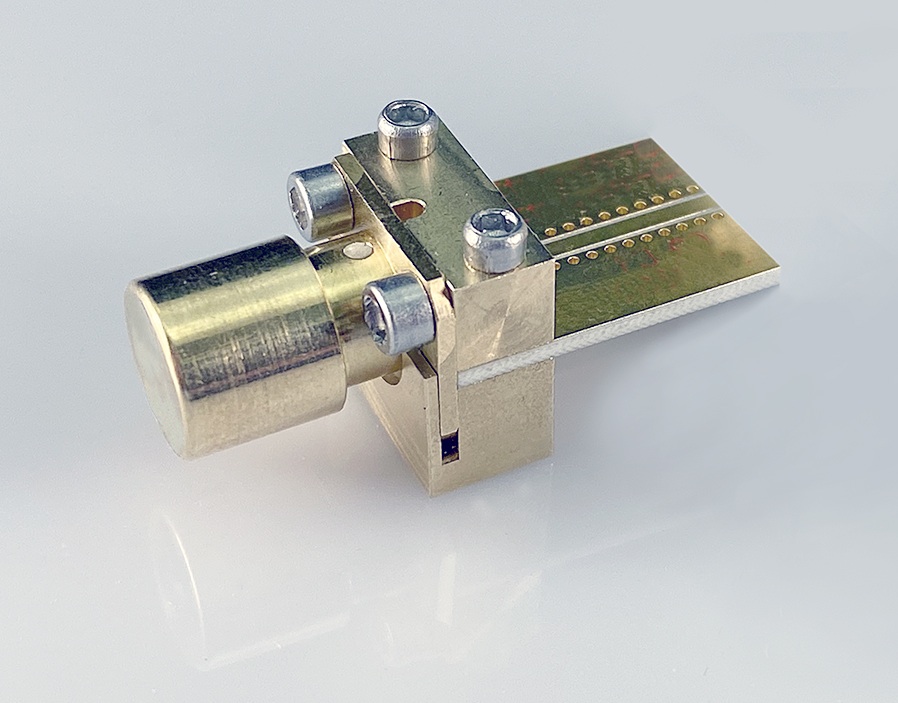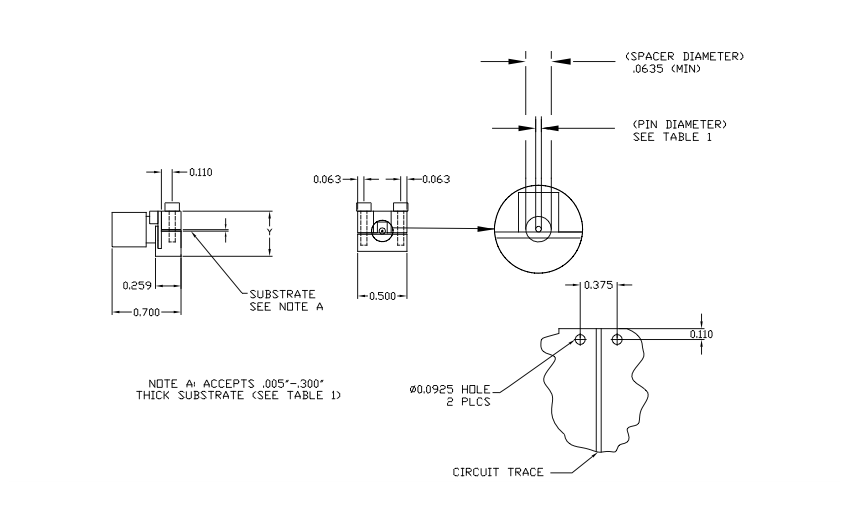KAT27010B-4×5
SPECIFICATIONS
Model Number
Freq. Min. (GHz)
Freq. Max. (GHz)
1.4:1, 18-27 GHz
FEATURES
DC – 27 GHz Frequency Operation
Low VSWR
50 Ohm Matched Assembly
Superior Electrical Performance
Operating Temperature: -65 to +125°C
Custom Designs Available
Product Description
KRYTAR has developed a line of End Launch Terminations featuring a unique, patent-pending, integrated termination eliminating the additional cost and complexity of typical coaxial terminations.
End Launch connectors are mechanical designs where a coaxial connector is used to connect a cable to a printed circuit test board. The connector is mounted at the end or edge of the board. This connector is used to transition microwave energy through the coaxial cable to a circuit on the PCB. End Launch coaxial connectors are generally frequency limited based on the type of coaxial connector used in the design. For many applications the connectors are terminated by soldering them directly to the PCB. Other termination options include the mating of two coaxial devices to function as a termination.
KRYTAR’s End Launch Model KAT27010B-4×5 offers superior performance ratings including: Operating Frequency range from DC to 27 GHz; VSWR: 1.2:1, DC-18 GHz, 1.4:1, 18-27 GHz; Impedance: 50 ±1 Ohm; Launch Pin Diameter (Inch) is 0.010; Substrate Thickness is (Inch): 0.1-0.2; Power Rating: 0.5 Watts; and Operating temperature of -64° to 125° C.
The KRYTAR End Launch Terminations have an integrated termination built-in thereby eliminating the additional cost and complexity of typical coaxial terminations. With the termination already integrated, these complete End Launch Termination packages offer a simple solution for reducing the time-consuming task required to install separate coaxial terminations. In addition, the fully integrated End Launch Termination offers superior electrical performance while avoiding the need to match individual components in the field.
KRYTAR also offers complete engineering services for custom designs that meet or exceed critical performance and/or packaging specifications.
Common Definitions
| Microwave Frequency Bands | |
| Band Designation | Frequency Range (GHz) |
| UHF | 300 MHz – 1.0 GHz |
| L | 1.0 – 2.0 |
| S | 2.0 – 4.0 |
| C | 4.0 – 8.0 |
| X | 8.0 – 12.0 |
| DBS | 12.2 – 12.7 |
| Ku | 12.0 – 18.0 |
| K | 18.0 – 26.5 |
| Ka | 26.5 – 40.0 |
| Q | 30.0 – 50.0 |
| U | 40.0 – 60.0 |
| V | 50.0 – 75.0 |
Gigahertz (GHz): A unit of measurement denoting the number of cycles in one second. One GHz is one billion cycles every second.
Megahertz (MHz): Equal to 1 million Hz. Uses the SI Prefix Mega, meaning 10^6.
VSWR (Voltage Standing Wave Ratio): The ratio of the maximum voltage to the minimum voltage in standing wave pattern along the length of a transmission line structure. It varies from 1 to (plus) infinity and is always positive. VSWR can be converted to return loss or the reflection coefficient.
Frequency Sensitivity is the amount of frequency change in the carrier frequency per unit amplitude change in the message signal.
Operating Temperature: An operating temperature is the temperature at which an electrical device operates. The device will operate effectively within a specified temperature range which varies based on the device function and application context, and ranges from the minimum operating temperature to the maximum operating temperature (or peak operating temperature). Outside this range of safe operating temperatures the device may fail.
5G
The fifth generation (5G) of cellular service, superseding 4G LTE. Governed by the 3GPP, 5G will increase transmission speed dramatically and embrace prioritization. As wireless data increases exponentially, real-time content such as video calling and video streaming must be given a higher priority than data on Web pages.
5G NR (5G New Radio)
The 5G new radio access technology (RAT) air-interface is a global standard, which like 4G also uses OFDM modulation, and is designed to deliver data rates up to 20 Gbps, enabling individual users to get gigabit-per-second downloads over the air (OTA). Wireless virtual reality (VR) and augmented reality (AR) can become commonplace, and 5G is expected to provide a huge boost for connecting billions of Internet of Things (IoT) devices.
Wi-Fi 6
Wi-Fi 6 is the most recent iteration of the IEEE standard for wireless local-area network (WLAN) protocol and is a substantial upgrade over its predecessors Wi-Fi 4 and Wi-Fi 5. Wi-Fi 6 operates between 2.4 GHz and 5 GHz. Wi-Fi 6 can be significantly faster due to technologies like traffic prioritization, OFDMA, and beamforming.
Wi-Fi 6E
Wi-Fi 6E operates at 6 GHz (5.925–7.125 GHz in the U.S.) and also the 2.4 GHz or 5 GHz devices already in use. Wi-Fi 6E-enabled devices can take advantage of the newer 6 GHz frequency band for further improved connectivity.
Common Definitions
| Microwave Frequency Bands | |
| Band Designation | Frequency Range (GHz) |
| UHF | 300 MHz – 1.0 GHz |
| L | 1.0 – 2.0 |
| S | 2.0 – 4.0 |
| C | 4.0 – 8.0 |
| X | 8.0 – 12.0 |
| DBS | 12.2 – 12.7 |
| Ku | 12.0 – 18.0 |
| K | 18.0 – 26.5 |
| Ka | 26.5 – 40.0 |
| Q | 30.0 – 50.0 |
| U | 40.0 – 60.0 |
| V | 50.0 – 75.0 |
Gigahertz (GHz): A unit of measurement denoting the number of cycles in one second. One GHz is one billion cycles every second.
Megahertz (MHz): Equal to 1 million Hz. Uses the SI Prefix Mega, meaning 10^6.
VSWR (Voltage Standing Wave Ratio): The ratio of the maximum voltage to the minimum voltage in standing wave pattern along the length of a transmission line structure. It varies from 1 to (plus) infinity and is always positive. VSWR can be converted to return loss or the reflection coefficient.
Frequency Sensitivity is the amount of frequency change in the carrier frequency per unit amplitude change in the message signal.
Operating Temperature: An operating temperature is the temperature at which an electrical device operates. The device will operate effectively within a specified temperature range which varies based on the device function and application context, and ranges from the minimum operating temperature to the maximum operating temperature (or peak operating temperature). Outside this range of safe operating temperatures the device may fail.
5G
The fifth generation (5G) of cellular service, superseding 4G LTE. Governed by the 3GPP, 5G will increase transmission speed dramatically and embrace prioritization. As wireless data increases exponentially, real-time content such as video calling and video streaming must be given a higher priority than data on Web pages.
5G NR (5G New Radio)
The 5G new radio access technology (RAT) air-interface is a global standard, which like 4G also uses OFDM modulation, and is designed to deliver data rates up to 20 Gbps, enabling individual users to get gigabit-per-second downloads over the air (OTA). Wireless virtual reality (VR) and augmented reality (AR) can become commonplace, and 5G is expected to provide a huge boost for connecting billions of Internet of Things (IoT) devices.
Wi-Fi 6
Wi-Fi 6 is the most recent iteration of the IEEE standard for wireless local-area network (WLAN) protocol and is a substantial upgrade over its predecessors Wi-Fi 4 and Wi-Fi 5. Wi-Fi 6 operates between 2.4 GHz and 5 GHz. Wi-Fi 6 can be significantly faster due to technologies like traffic prioritization, OFDMA, and beamforming.
Wi-Fi 6E
Wi-Fi 6E operates at 6 GHz (5.925–7.125 GHz in the U.S.) and also the 2.4 GHz or 5 GHz devices already in use. Wi-Fi 6E-enabled devices can take advantage of the newer 6 GHz frequency band for further improved connectivity.



